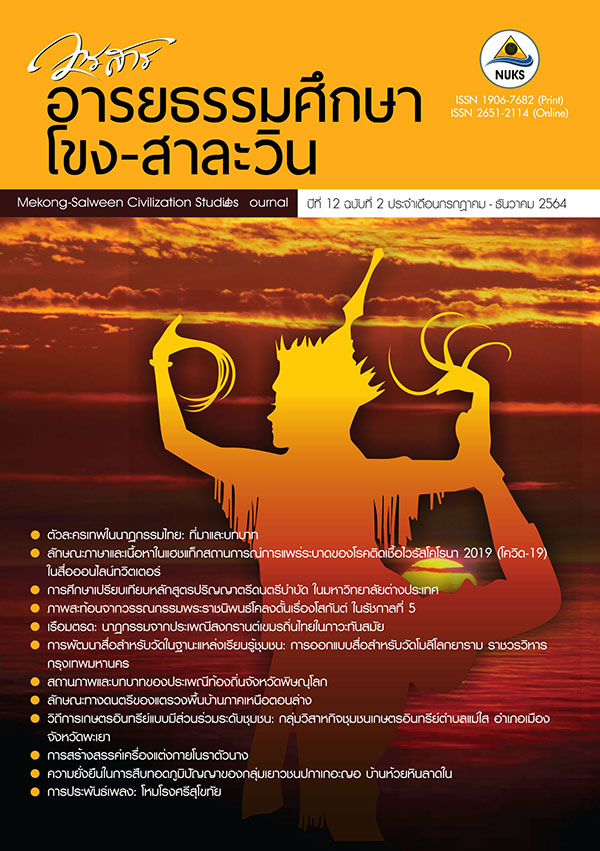Features of Language and Contents in COVID – 19 Hashtags on Twitter ลักษณะภาษาและเนื้อหาในแฮชแท็กสถานการณ์การแพร่ระบาดของโรคติดเชื้อไวรัสโคโรนา 2019 (โควิด-19) ในสื่อออนไลน์ทวิตเตอร์
Main Article Content
Abstract
This study focused on the features of language and contents analysis of the COVID – 19 hashtags on Thai Twitter. The hashtags data used in this study were collected from three periods of the COVID – 19 pandemic situation’s occurred as follows: 1) March – April 2020, 2) December 2020 – January 2021, and 3) April – May 2021. The results showed that, in the 97 hashtags, the most frequent type of grammatical units found was sentence units (44.3%), followed by word units (28.87%), phrase units (25.77%), and clause units (1.03%). In terms of language formats, there were three types as follows: 1) using English transliterations, 2) mixing Thai and English alphabets, and 3) using abbreviations. Additionally, there were 11 topics of the COVID – 19 pandemic situation contents. There were 3 topics that were twitted by the Twitter users for all three periods as follows: 1) the COVID – 19 pandemic situations, 2) the COVID – 19 preventive measures, and 3) the COVID – 19 relieved pandemic situations.
Downloads
Article Details
References
BBC Thai. (2020). Covid-19: Ministry of Public Health announces a new wave of outbreaks in Thailand Nearly 700 cases of Samut Sakhon cases in 3 days. Retrieved July 7, 2021, from http://www.bbc.com/thai/thailand-55383363
Crystal, D. (2005). The scope of Internet linguistics. Paper presented at the Proceedings of American Association for the Advancement of Science Conference; American Association for the Advancement of Science Conference, Washington, DC, USA. Getdaytrends. (n.d.). Twitter Trends. Retrieved May 15, 2021, from https://getdaytrends.com
Getdaytrends. (n.d.). Twitter Trends. Retrieved May 15, 2021, from https://getdaytrends.com
Government Gazette. (2020). Declaration of an Emergency Situation in all areas of the Kingdom of Thailand. Retrieved July 19, 2021, from http://www.ratchakitcha.soc.go.th/DATA/PDF/2563/E/069/T_0001.PDF
Government Gazette. (2020). Order of the Prime Minister No. 5 /2563 Re: Establishment of a Special Task Force to Perform Duties in Accordance with the Emergency Decree on Public Administration in Emergency Situations B.E. 2548 (2005). Retrieved July 5, 2021, from http://www.ratchakitcha.soc.go.th/DATA/PDF/2563/E/069/T_0006.PDF
Jurairat. (2020). What is “COVID-19” and how its symptom. Retrieved July 7, 2021, from http://www.sanook.com/health/20609/
Klymenko, O. (2019). Twitterverse: The birth of new words. Proceedings of the Linguistic Society of America, 4 (11), 1-12.
Newton, C. (2017, November 7). Twitter is Rolling out 280-Character Tweets around the World. Retrieved from http:// www.theverge.com/2017/11/7/16616076/twitter-280-characters-global-rollout.
Panthumatha, N. (2008). Thai Grammar. (4th ed.) Bangkok: Chulalongkorn University.
Panyametheekul, S. (2005). Conversational Dominance in a Thai Chat Room. Manutsat Paritat : Journal of Humanities, 27(1), 63-71.
Phanuphong, W. (1989). Structure of Thai Language: Grammar. (10th ed.). Bangkok: Ramkhamhaeng University Press.
Phichaphat, P. (2010). Credibility of "Twitter" social media and mainstream media (Master’s Thesis). Chulalongkorn University, Bangkok.
Phothisiintorn, C. (2015). A Study of Marketing Mix Factor of #Hashtag in Twitter Influencing Twitter Users’
Decision Making for Purchasing of Bakery Shop. (Master’s Independent Study). Bangkok University. Bangkok.
Positioning. (2019). What date and time should post socail media. Retrieved June 24, 2021, from http://positioningmag.com/1239864
Prasithrathsint, A., Hoonchamlong, Y., & Savetamalya, S. (2011). Grammatical Theories. (3th ed.) Bangkok: Chulalongkorn University.
Promdirake, J. (2015). Expectation, Exposure, and Participation in Using Campaign Hashtags in Thailand (Master’s Thesis). Thammasat University, Bangkok.
Shapp, A. (2014). Variation in the Use of Twitter Hashtags. (Qualifying Paper in Sociolinguistics.) New York University, New York.
Upakitsinlapasan, Praya. (2005). Principles of Thai Language. (13th ed.). Bangkok: Thaiwatthanaphanit.
Wicke, P., & Bolognesi, M. M. (2020). Framing COVID-19: How we conceptualize and discuss the pandemic on Twitter. Plos One, 15(9), e0240010. doi:10.1371/journal.pone.0240010


